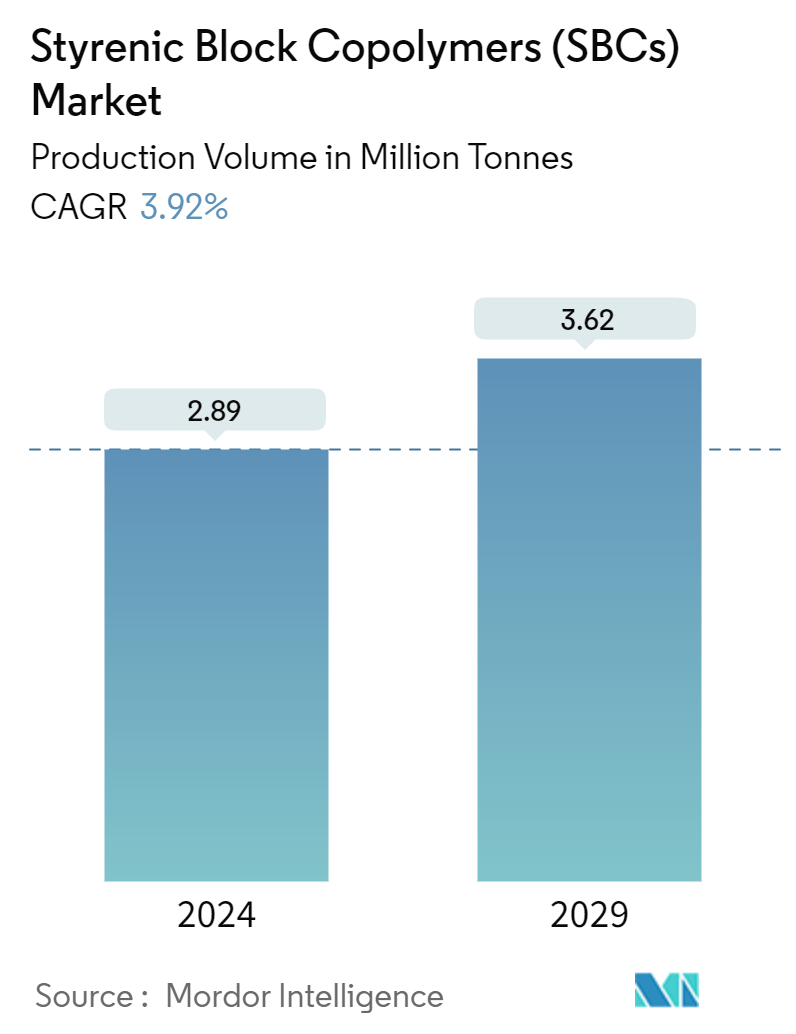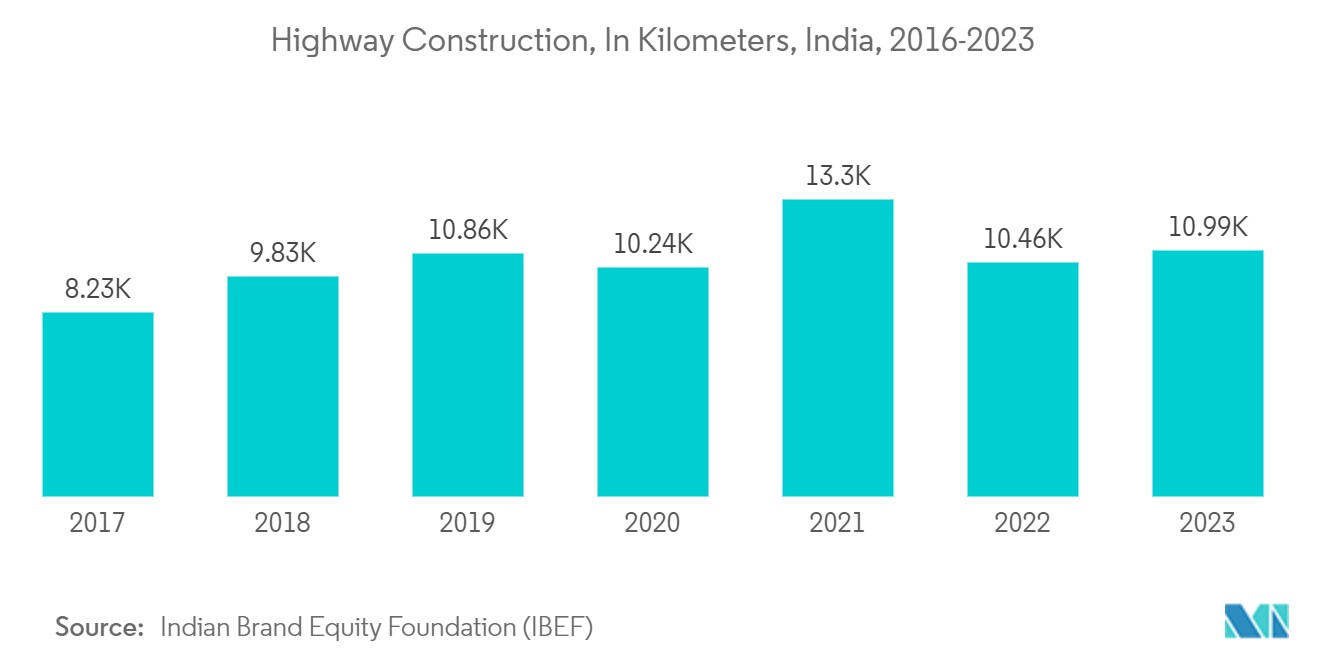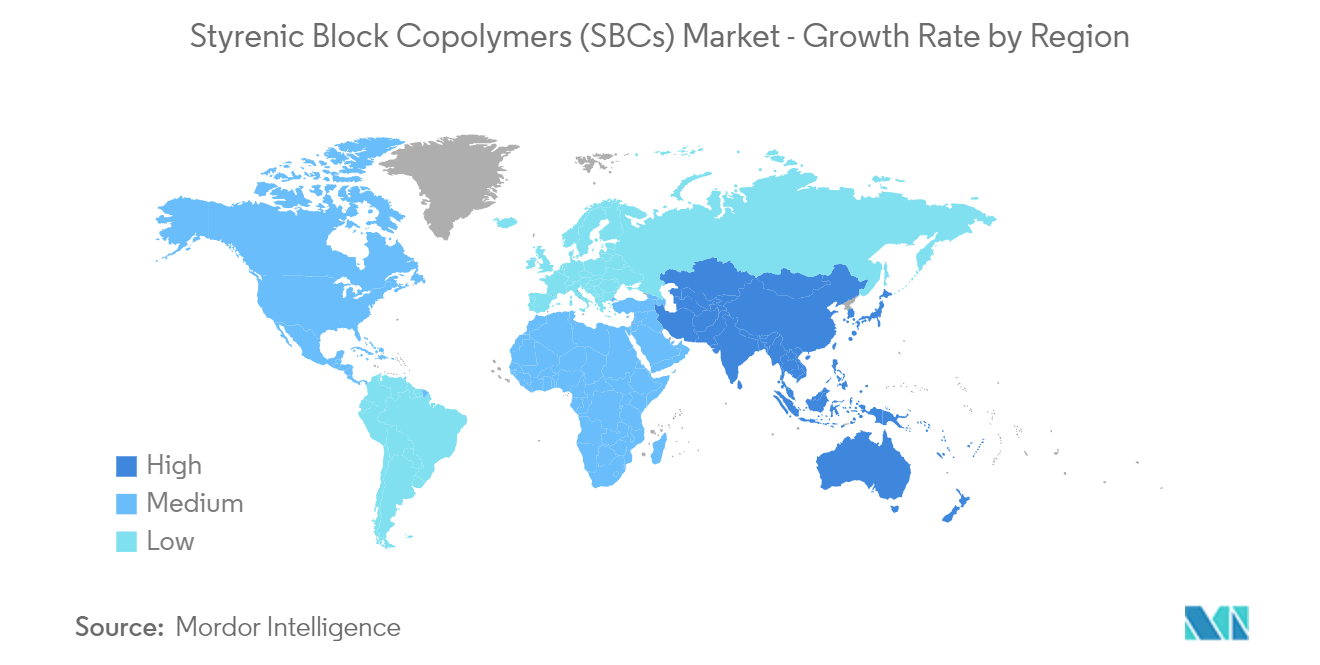Styrenic Block Copolymers (SBCs) Market Size

| Study Period | 2019 - 2029 |
| Base Year For Estimation | 2023 |
| CAGR (2024 - 2029) | 3.92 % |
| Fastest Growing Market | Asia Pacific |
| Largest Market | Asia Pacific |
| Market Concentration | High |
Major Players-Market---Key-Players.webp)
*Disclaimer: Major Players sorted in no particular order |
Styrenic Block Copolymers (SBCs) Market Analysis
The Styrenic Block Copolymers Market size in terms of production volume is expected to grow from 2.89 Million tonnes in 2024 to 3.62 Million tonnes by 2029, at a CAGR of 3.92% during the forecast period (2024-2029).
The COVID-19 pandemic hampered the styrenic block copolymers market. Considering this scenario, building and construction activities were stopped temporarily during the lockdown to curb the spread of the virus. According to Eurostat, the construction industry declined by 28.4% in the EU-19 countries and by 24% in the European Union (EU-27) countries, thereby witnessing a reduction in demand for styrene-butadiene-styrene (SBS). However, the market registered a significant growth rate after the restrictions were lifted due to the increasing demand from asphalt modification (paving and roofing) and footwear industries.
Over the short term, increasing applications in bitumen modification and the rising adoption in the footwear industry are expected to stimulate market demand.
However, the growing focus on asphalt-free construction of roads and roofing is expected to restrain market growth.
Growth opportunities in hot-melt adhesives are likely to create market opportunities in the coming years.
Asia-Pacific is expected to dominate the market and is likely to witness the highest CAGR during the forecast period.
Styrenic Block Copolymers (SBCs) Market Trends
The Asphalt Modification Segment to Dominate the Market
- Asphalt is an important construction material for roads, airport runways, taxiways, bicycle paths, etc.
- Modifiers, such as binder modifiers (SBCs), improve the performance of asphalt pavements by increasing their resistance to pavement distresses, such as thermal cracking, rutting, stripping, etc., thereby prolonging their service life.
- In recent years, the demand for modified bitumen used in asphalt has been witnessing steady growth. This demand directly correlates with ongoing road construction activities. Roadways and walkways are under continuous stress as they are subjected to heavy loads daily. They require maintenance and are subject to repair from time to time. Moreover, how roads are built and maintained significantly impacts the energy that is burned by the vehicles that roll or crawl on the surface.
- Governments worldwide are spending money to restore or expand existing roadways in the developed world and construct entirely new ones in the developing world.
- For instance, in September 2022, the European Commission released EUR 5 billion (USD 5.29 billion) through the Connecting Europe Facility (CEF) in infrastructure projects, which will include roadways and walkways, targeting mainly the trans-European transport network (TEN-T network) and multimodal transport.
- Moreover, 65% of the asphalt pavement market in the United States can be accounted for publicly funded highway projects, with residential and non-residential construction making up the remaining 35%. Capital spending on highways, roads, and bridges by all levels of government (federal/state/local) is around USD 80 billion annually, about half of which comes from federal funding.
- Furthermore, the Federal Highway Administration (FHWA) does not track pavement type for 1.89 million miles of local roads where the use of SBC is significant.
- As per the report of the Indian Brand Equity Foundation (IBEF), highway construction in India increased from 10,457 km in 2022 to 10,993 km in 2023.
- All such factors are likely to increase the demand for asphalt modification, which will, in turn, increase the growth of styrenic block copolymers during the forecast period.

Asia-Pacific to Dominate the Market
- Asia-Pacific represents the largest regional market for styrenic block copolymers market globally. The major countries responsible for the consumption of styrenic block copolymers in the region include China, India, and Japan.
- China is stepping up investment and highway construction as it scrambles to stabilize its economy following the recent outbreak of COVID-19 in major Chinese cities. According to the National Bureau of Statistics, China's capital investment reached CNY 28.59 trillion (~USD 3.91 trillion) in the first eight months of 2023, up by 6.8% compared to the same period in 2022.
- The National Development and Reform Commission (NDRC) and the Ministry of Transport announced in a joint news briefing that they would build a highway network that is fully functional, efficient, and safe by 2035. Moreover, China plans to build a 461,000 km highway network by 2035 and expand it into a world-class network by 2050.
- China is the largest manufacturer, consumer, and supplier of footwear. According to the World Footwear Yearbook 2023, in 2022, the country produced about 13,047 million pairs of footwear, while consumption was about 3,930 million, representing 17.9% of the total global footwear consumption. In the same year, the country exported about 9,308 million pairs of footwear, representing about 61.3% of the global exports of footwear.
- The construction sector in India, which is currently the third largest in the world, has the capability to become the largest in the world in the next 5 years, as per the Union Minister for Road Transport & Highways. According to the National Investment Promotion and Facilitation Agency, the construction Industry in India is expected to reach USD 1.4 trillion by 2025, thus supporting the demand for styrenic block copolymers from the industry.
- According to the Packaging Industry Association of India (PIAI), the country’s packaging sector is the fifth largest sector in its economy. The association has predicted that the packaging sector will reach USD 204.81 billion by 2025. This scenario may boost the demand for the market studied during the forecast period.
- The Japanese packaging industry, including food and pharmaceutical packaging, is expected to grow in the coming years. In the present market scenario, Japan has the world's highest per capita consumption of packaging materials. In Asia, Japan holds the second-highest packaged food consumption share, next to China. This is a good business opportunity for food and beverage packaging professionals.
- As per the Japan Packaging Institute (JPI), the total shipment value of the Japanese packaging industry was around JPY 6.58 trillion (~USD 0.05 trillion) in 2022 compared to around JPY 6.17 trillion (~USD 0.05 trillion) in the previous year. The food and beverage industry is expected to reach USD 62.71 million in 2024 and is projected to reach USD 80.53 million by 2027, as per Statista forecast. Such trends in the food and beverage industry are expected to boost the demand for packaging, uplifting the polymer modification application of the market studied in the coming years.
- Owing to the factors mentioned above, the market for styrenic block copolymers in Asia-Pacific is projected to grow significantly during the forecast period.

Styrenic Block Copolymers (SBCs) Industry Overview
The styrenic block copolymers (SBCs) market is partially consolidated in nature. Some of the major players in the market include China Petrochemical Corporation (SINOPEC), LCY Group, TSRC Corporation, Dynasol Group, and Kraton Corporation (not in any particular order).
Styrenic Block Copolymers (SBCs) Market Leaders
-
LCY GROUP
-
KRATON CORPORATION
-
China Petrochemical Corporation (SINOPEC)
-
TSRC Corporation
-
Dynasol Group
*Disclaimer: Major Players sorted in no particular order
-Market---Market-Concentration.webp)
Styrenic Block Copolymers (SBCs) Market News
- March 2022: DL Chemical Co. Ltd acquired Kraton Corporation for approximately USD 2.5 billion. The merger enables Kraton to strengthen its global presence by leveraging DL Chemical's manufacturing capabilities and footprint in the Asian market, along with its financial strength. This allows Kraton to further invest in industry-leading sustainable innovation.
- March 2022: Kraton Corporation announced its collaboration with SABIC to produce ISCC PLUS-certified renewable styrenic block copolymers (SBC) at Kraton’s manufacturing facility in Berre, France.
Styrenic Block Copolymers Market Report - Table of Contents
1. INTRODUCTION
- 1.1 Study Assumptions
- 1.2 Scope of the Study
2. RESEARCH METHODOLOGY
3. EXECUTIVE SUMMARY
4. MARKET DYNAMICS
-
4.1 Drivers
- 4.1.1 Increasing Application in Bitumen Modification
- 4.1.2 Rising Adoption in the Footwear Industry
-
4.2 Restraints
- 4.2.1 Growing Focus on Asphalt-free Construction of Roads and Roofing
- 4.3 Industry Value Chain Analysis
-
4.4 Porter's Five Forces Analysis
- 4.4.1 Bargaining Power of Suppliers
- 4.4.2 Bargaining Power of Buyers
- 4.4.3 Threat of New Entrants
- 4.4.4 Threat of Substitute Products and Services
- 4.4.5 Degree of Competition
- 4.5 Price Overview (2019-2029)
5. MARKET SEGMENTATION (Market Size in Volume)
-
5.1 Type
- 5.1.1 Styrene-Butadiene-Styrene (SBS)
- 5.1.2 Styrene-Isoprene-Styrene (SIS)
- 5.1.3 Hydrogenated SBC (HSBC)
-
5.2 Application
- 5.2.1 Asphalt Modification (Paving and Roofing)
- 5.2.2 Footwear
- 5.2.3 Polymer Modification
- 5.2.4 Adhesives and Sealants
- 5.2.5 Other Applications
-
5.3 Geography
- 5.3.1 Asia-Pacific
- 5.3.1.1 China
- 5.3.1.2 India
- 5.3.1.3 Japan
- 5.3.1.4 South Korea
- 5.3.1.5 Malaysia
- 5.3.1.6 Thailand
- 5.3.1.7 Indonesia
- 5.3.1.8 Vietnam
- 5.3.1.9 Rest of Asia-Pacific
- 5.3.2 North America
- 5.3.2.1 United States
- 5.3.2.2 Canada
- 5.3.2.3 Mexico
- 5.3.3 Europe
- 5.3.3.1 Germany
- 5.3.3.2 United Kingdom
- 5.3.3.3 Italy
- 5.3.3.4 France
- 5.3.3.5 Russia
- 5.3.3.6 Spain
- 5.3.3.7 Turkey
- 5.3.3.8 Nordic Countries
- 5.3.3.9 Rest of Europe
- 5.3.4 South America
- 5.3.4.1 Brazil
- 5.3.4.2 Argentina
- 5.3.4.3 Colombia
- 5.3.4.4 Rest of South America
- 5.3.5 Middle East and Africa
- 5.3.5.1 Saudi Arabia
- 5.3.5.2 United Arab Emirates
- 5.3.5.3 Qatar
- 5.3.5.4 Egypt
- 5.3.5.5 Nigeria
- 5.3.5.6 South Africa
6. COMPETITIVE LANDSCAPE
- 6.1 Mergers and Acquisitions, Joint Ventures, Collaborations, and Agreements
- 6.2 Market Ranking Analysis
- 6.3 Strategies Adopted by Leading Players
-
6.4 Company Profiles
- 6.4.1 Avient Corporation
- 6.4.2 China Petrochemical Corporation (Sinopec)
- 6.4.3 Grupo Dynasol
- 6.4.4 INEOS
- 6.4.5 Kraton Corporation
- 6.4.6 Kuraray Co. Ltd
- 6.4.7 LCY Group
- 6.4.8 LG Chem
- 6.4.9 TSRC
- 6.4.10 Versalis SPA
- 6.4.11 Zeon Corporation
- *List Not Exhaustive
7. MARKET OPPORTUNITIES AND FUTURE TRENDS
- 7.1 Growth Opportunities in Hot-melt Adhesives
Styrenic Block Copolymers (SBCs) Industry Segmentation
Styrenic block copolymers (SBCs) are a class of thermoplastic elastomers that process like plastic and behave like rubber, mainly due to the physical crosslink inherent in the SBC structure. When the SBC material is stretched, those crosslinks bring it back to its original shape. SBCs can be made from raw materials such as butadiene, styrene, and isoprene. They have a two-phase structure composed of hard polystyrene end blocks and soft rubber mid-locks. SBCs are used in asphalt modification, rigid thermoplastic impact modification, and production of soft plastic elastomer.
The styrenic block copolymers market is segmented by type, application, and geography. By type, the market is segmented into styrene-butadiene-styrene (SBS), styrene-isoprene-styrene (SIS), and hydrogenated SBC (HSBC). By application, the market is segmented into asphalt modification, footwear, polymer modification, adhesives and sealants, and other applications. The report also covers the market size and forecasts for the styrenic block copolymers (SBCs) market in 27 countries across major regions. For each segment, the market sizing and forecasts are done on the basis of volume (tons).
| Type | Styrene-Butadiene-Styrene (SBS) | |
| Styrene-Isoprene-Styrene (SIS) | ||
| Hydrogenated SBC (HSBC) | ||
| Application | Asphalt Modification (Paving and Roofing) | |
| Footwear | ||
| Polymer Modification | ||
| Adhesives and Sealants | ||
| Other Applications | ||
| Geography | Asia-Pacific | China |
| India | ||
| Japan | ||
| South Korea | ||
| Malaysia | ||
| Thailand | ||
| Indonesia | ||
| Vietnam | ||
| Rest of Asia-Pacific | ||
| Geography | North America | United States |
| Canada | ||
| Mexico | ||
| Geography | Europe | Germany |
| United Kingdom | ||
| Italy | ||
| France | ||
| Russia | ||
| Spain | ||
| Turkey | ||
| Nordic Countries | ||
| Rest of Europe | ||
| Geography | South America | Brazil |
| Argentina | ||
| Colombia | ||
| Rest of South America | ||
| Geography | Middle East and Africa | Saudi Arabia |
| United Arab Emirates | ||
| Qatar | ||
| Egypt | ||
| Nigeria | ||
| South Africa |
Styrenic Block Copolymers Market Research FAQs
How big is the Styrenic Block Copolymers Market?
The Styrenic Block Copolymers Market size is expected to reach 2.89 million tonnes in 2024 and grow at a CAGR of 3.92% to reach 3.62 million tonnes by 2029.
What is the current Styrenic Block Copolymers Market size?
In 2024, the Styrenic Block Copolymers Market size is expected to reach 2.89 million tonnes.
Who are the key players in Styrenic Block Copolymers Market?
LCY GROUP, KRATON CORPORATION, China Petrochemical Corporation (SINOPEC), TSRC Corporation and Dynasol Group are the major companies operating in the Styrenic Block Copolymers Market.
Which is the fastest growing region in Styrenic Block Copolymers Market?
Asia Pacific is estimated to grow at the highest CAGR over the forecast period (2024-2029).
Which region has the biggest share in Styrenic Block Copolymers Market?
In 2024, the Asia Pacific accounts for the largest market share in Styrenic Block Copolymers Market.
What years does this Styrenic Block Copolymers Market cover, and what was the market size in 2023?
In 2023, the Styrenic Block Copolymers Market size was estimated at 2.78 million tonnes. The report covers the Styrenic Block Copolymers Market historical market size for years: 2019, 2020, 2021, 2022 and 2023. The report also forecasts the Styrenic Block Copolymers Market size for years: 2024, 2025, 2026, 2027, 2028 and 2029.
Styrenic Block Copolymers (SBCs) Industry Report
The Styrenic Block Copolymers (SBCs) market report provides a comprehensive industry analysis, detailing the market segmentation by type, application, and geography. This report offers valuable industry information, including market data and industry statistics, which are essential for understanding the current market trends and market value.
The industry reports highlight the significant market growth observed in the SBCs market, driven by various applications such as asphalt modification, footwear, polymer modification, adhesives and sealants, and other uses. The market forecast outlines the expected industry outlook and market predictions, helping stakeholders anticipate future market trends and market growth.
The report example includes a detailed market overview and market review, offering insights into the market leaders and their strategies. With a focus on market size and market share, the report provides an in-depth industry overview, supported by industry research and market analysis.
The industry sales and industry size are discussed, providing a clear picture of the market dynamics. Additionally, the report includes a report PDF for easy access to the complete analysis and findings. The research companies involved in this study have ensured that the market forecast is accurate and reliable.
Overall, this report serves as a valuable resource for understanding the market trends, industry outlook, and market segmentation of the Styrenic Block Copolymers (SBCs) market.



